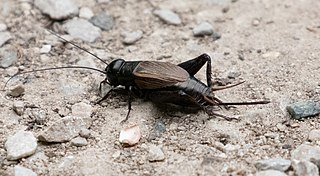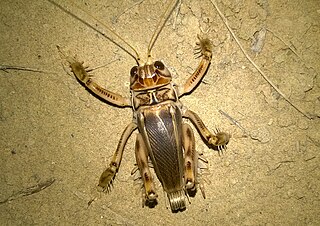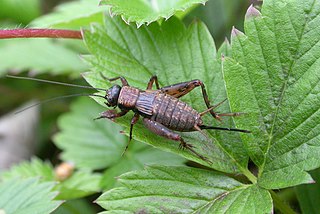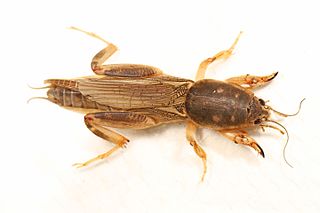
Anostostomatidae is a family of insects in the order Orthoptera, widely distributed in the southern hemisphere. It is named Mimnermidae or Henicidae in some taxonomies, and common names include king crickets in Australia and South Africa, and wētā in New Zealand. Prominent members include the Parktown prawn of South Africa, and the giant wētā of New Zealand.

Mole crickets are members of the insect family Gryllotalpidae, in the order Orthoptera. Mole crickets are cylindrical-bodied, fossorial insects about 3–5 cm (1.2–2.0 in) long as adults, with small eyes and shovel-like fore limbs highly developed for burrowing. They are present in many parts of the world and where they have arrived in new regions, may become agricultural pests.

Gryllinae, or field crickets, are a subfamily of insects in the order Orthoptera and the family Gryllidae.

Gryllotalpa gryllotalpa, commonly known as the European mole cricket, is widespread in Europe and has been introduced to the eastern United States. Its scientific name is derived from the Latin 'gryllus' (cricket); and 'talpa' (mole), because of the fine dense fur which covers it and its subterranean habits, and because of the mole-like forelegs adapted for digging, a good example of convergent evolution.

Gryllus pennsylvanicus is known as the fall field cricket. G. pennsylvanicus is common in southern Ontario, is widespread across much of North America and can be found even into parts of northern Mexico. It tends to be absent in most of the southwestern United States including southern California. Within its geographic range this field cricket will burrow into soil in fields and forest edges. Individuals inhabit grassy disturbed areas and are often found around areas of human habitation.

Gryllus veletis, commonly known as the spring field cricket, is abundant throughout eastern North America. G. veletis is a solitary, aggressive, omnivorous, burrow-inhabiting species of cricket. This species is commonly confused with Gryllus pennsylvanicus, as they inhabit the same geographical area. However, the two species are easily distinguished through examination of life history, ovipositor and behavioural differences. Predators of G. veletis include American toads, wild turkeys, red-tailed hawks, wolf spiders and red-backed salamanders.

Crickets are orthopteran insects which are related to bush crickets, and, more distantly, to grasshoppers. In older literature, such as Imms, "crickets" were placed at the family level, but contemporary authorities including Otte now place them in the superfamily Grylloidea. The word has been used in combination to describe more distantly related taxa in the suborder Ensifera, such as king crickets and mole crickets.

Schizodactylus monstrosus or the maize cricket, is a species of large, robust cricket found in Asia, belonging to the family Schizodactylidae. It is found mainly in sandy habitats along rivers, and has large flattened tarsal extensions and wings that are curled at the tip, right above the cerci. They are nocturnal and show a high degree of variation in activity during the day and night. They hide in burrows that they dig on their own during the day.

The Tridactylidae are a family in the insect order Orthoptera. They are small, mole-cricket-like insects, almost always less than 20 mm (0.79 in) long when mature. Generally they are shiny, dark or black, sometimes variegated or sandy-coloured. They commonly live in short tunnels and are commonly known as pygmy mole crickets, though they are not closely related to the true "mole crickets" (Ensifera), as they are included in the Caelifera suborder.

Hemiandrus pallitarsis is a species of ground weta endemic to New Zealand. This nocturnal species hides in burrows during the day, and can be an important food for kiwi. They can be identified by a single foretibial spine, three prolateral spines, and four retrolateral spines on the mesotibia, and their tibia lacks a tympanal membrane. The female has an unusual appendage on her abdomen, and the male has blackened hooks on his last tergite. They have a two-year life cycle, and their diet is largely unknown. Unusually for an insect, the female shows maternal care towards her eggs and nymphs.

Oecanthus fultoni, also known as the snowy tree cricket, or thermometer cricket, is a species of tree cricket from North America. It feeds on leaves but also damages fruit. The chirp of this species is often dubbed onto sound tracks of films and television shows to depict a quiet summer's night. The rate of chirp varies depending on the heat of the environment, allowing a listener to estimate the temperature.
Gryllus integer, commonly known as the western trilling cricket, is one of many species of field cricket in the genus Gryllus. It is called the "triller" field cricket because its song is nearly continuous rather than broken into discrete chirps. G. integer can be found in parts of the Western United States, having been recorded from Oregon, California, Arizona and New Mexico.

Teleogryllus commodus, commonly known as the black field cricket, is a cricket species native to Australia. They are significant pests to most plants in Australia and New Zealand. T. commodus belongs to the order Orthoptera, the family Gryllidae which are characterized by wings that are folded on the side of the body, chewing mouthparts and long, thin antennae. T. commodus has the ability to learn via the recognition of rewards. They are also capable of odour recognition and thus can be taught via odour pairing.

Neoscapteriscus vicinus, commonly known as the tawny mole cricket, is a species of insect in the mole cricket family, Gryllotalpidae. This species is native to South America and also occurs in the Southern United States, where it arrived as a contaminant of ship's ballast around 1900. Colombian insect taxonomist Oscar Cadena-Castañeda studied specimens of the genus which had been called Scapteriscus, and decided that it included two groups; a smaller group and a larger group that he named Neoscapteriscus in 2015. North American mole cricket taxonomists agreed with his decision and altered Orthoptera Species File Online accordingly.

Anurogryllus, commonly known as short-tailed crickets, is a genus of crickets in the tribe Gryllini; species are recorded from the Americas. The common and scientific names derive from the vestigial, poorly developed ovipositors of females.

Brachytrupes membranaceus, the tobacco cricket, is a species of cricket in the family Gryllidae. It is a pest of crops including young tobacco plants. There are four subspecies, all of which are native to Africa.

Anurogryllus muticus, also known as De Geer's short-tailed cricket or simply short-tailed cricket is a species of cricket in the family Gryllidae.

Nemobius sylvestris, the wood cricket, is a flightless species of cricket in the family Trigonidiidae. It is native to Western Europe and North Africa but uncommon in Britain.

Neoscapteriscus borellii, the southern mole cricket, is a species of insect in the family Gryllotalpidae.

Acanthogryllus fortipes, or the brown cricket, is a species of cricket from southern Africa. It is mostly dark brown in colour and has a large head. It is a common species in short grass, including artificial habitats such as lawns and fields.


















